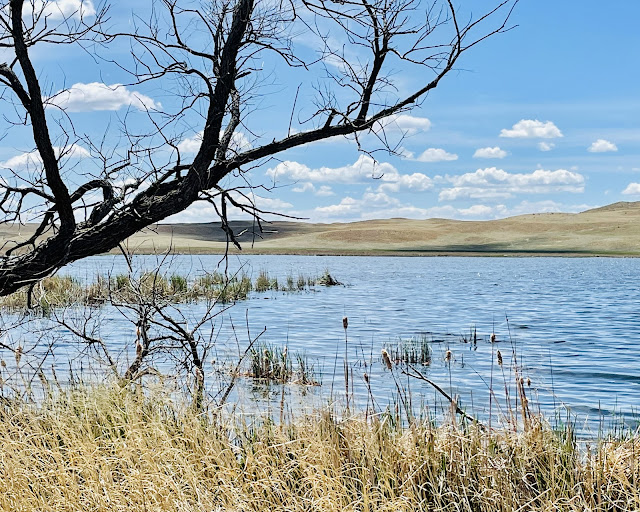Last Saturday morning, I went birding with my friend, Vonnie, who is extremely knowledgeable and passionate about all kinds of birds. I've always been excited to watch birds as they flit about from one branch to another, or quibble over a few seeds at a backyard bird feeder, but I can't say that I've ever before gone birding.
In the springtime, Vonnie and her parents and kids have been accustomed to taking car trips along Highway 2, between Alliance and Hyannis, just to watch the water birds that frequent the 26 lakes (or ponds, really) that line the road. I wouldn't know how many lakes there are, but Vonnie and her family have counted them. Vonnie's parents aren't healthy enough for birding this year, and her children are grown and scattered across the US and Canada, so she asked if I would like to go with her. Vonnie brought binoculars, and a notebook for recording each type of bird she saw. I brought a telephoto lens for my phone.
Vonnie and I had plenty to talk about as she drove the 45 miles from Gering to Alliance. After we stopped for gas and a restroom break, we were ready for the real purpose of our trip; it wasn't long before we pulled over to peer at the first roadside pond.
 |
| This American Avocet (in the center) was the first bird we spotted. Vonnie knew its name, just as she knew the names of nearly every bird we saw. I know some of the more common birds by name, but I'm glad I have my smart phone to help me identify others from the photos I've taken. |
I was fascinated to see several wading birds in the Ibis family.
 |
| These two ibises were startled by our presence, even though we stayed in the car, with our windows rolled down, so we could see clearly. |
 |
| This dove was perched on the top strand of the barbed wire fence that lined the road along the lakes. I have doves like this one in my own backyard; they like to perch on the top of my chimney, their coos echoing down into the kitchen below. |
 |
| I knew this bird was a duck. Vonnie knew it was a Northern Shoveler. |
.
 |
| We have had a rainy spring, so the wetlands were full of water. Later in the summer, though, some of the lakes may dry up. Short windmills, like the one in the distance, provide plenty of water for the livestock and wildlife, even when the lakes are dry. |
 |
It's quite entertaining to watch long-legged birds, like this Greater Yellowlegs, as they dip their bills under the water to scoop up some tasty insect larvae.
|
 |
| These Ring-necked Ducks were a little hard to see at times, because the wind was blowing just enough to make waves that caught the sunlight, partially obscuring the waterfowl whose protective coloring did the job God meant for it to do. |
The Common Grackle is as ordinary as its name, and Red-winged Blackbirds, like this one perched on a fence post, are also abundant throughout much of Nebraska in the spring and summer.
 |
| This Mallard flew to the other side of the lake as soon as it sensed our presence. |
 |
| Vonnie was hoping that this white bird would be an egret, but when we got closer, it was obviously just a gull. Although egrets can be a common sight in the area, we didn't see any that day. |
 |
Yellow-headed Blackbirds, like this one, are commonly found in the wetlands of Nebraska.
|
Vonnie and I spent nearly two hours leap-frogging from one lake to another, pulling off the highway each time we spotted some birds taking advantage of the wetlands alongside the road. Then, as the lakes petered out, we drove on to Hyannis, population 154, where we found a picnic table so we could sit awhile and eat the lunches we had brought with us. The weather was perfect for birding and picnicking outdoors: sunny, breezy, and 72 degrees.
Our trip home didn't take nearly as long as the trek to Hyannis, but we enjoyed every minute of our day.
Look at the birds. They don’t plant or harvest or store food in barns, for your heavenly Father feeds them. And aren’t you far more valuable to him than they are? |
Matthew 6:26




















Comments
Post a Comment